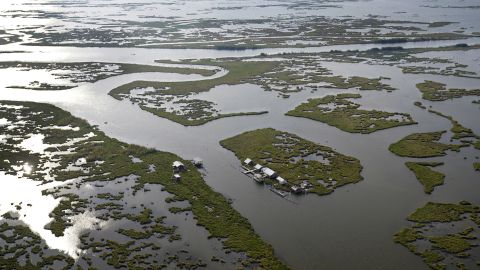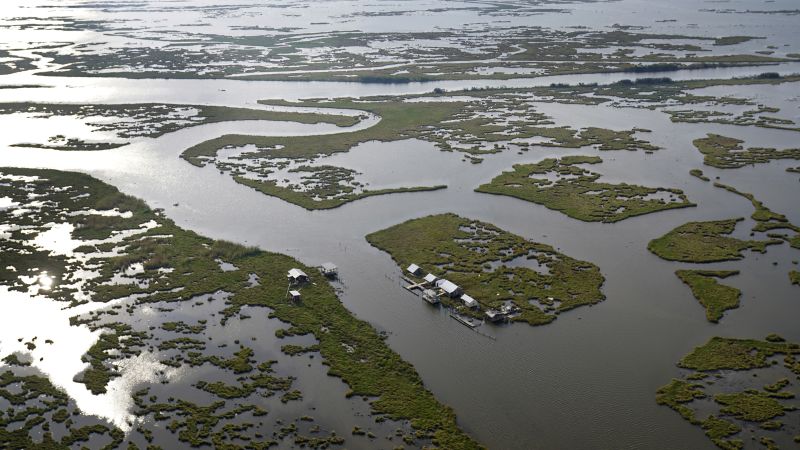CNN
—
About 3,000 residents in a Louisiana community south of New Orleans have been warned saltwater permeated their drinking water supply, posing a threat to residents with health risks.
Plaquemines Parish is not under a boil water advisory, but health officials are telling residents with high blood pressure or heart health issues not to drink the water after it was compromised due to water levels in the Mississippi River plummeting to record lows.
“It’s salty. You can smell the salt content,” Plaquemines Parish President Kirk Lepine told CNN in a phone interview. “It’s not suitable for people who have health risks.”
The water is safe for those who don’t suffer from health issues and is safe for bathing, according to Lepine.
The saltwater intrusion, which happens when saltwater moves into fresh water, is linked to water from the nearby Gulf of Mexico pouring into the region’s water system as severe drought caused water levels of the Mississippi River to plunge, slowing its flow and making it harder keep saltwater out.
“We can boil seafood now. We are trying to have a sense of humor about it, but it’s concerning, and we are watching it closely,” Lepine said.
In an advisory posted September 28, Plaquemines Parish officials said the Boothville water system was “experiencing higher levels of sodium and chloride from a salt water wedge that is moving up the Mississippi River.”
Officials said the contaminates were secondary, meaning they weren’t a threat to health but “could affect the taste, odor and color of drinking water,” according to the advisory.
Sodium levels detected in the parish’s drinking water ranged from 60 mg/L to 200 mg/L, the advisory said. The Environmental Protection Agency recommends sodium levels not exceed 20 mg/L for people on a low sodium diet.
“Individuals who are on these diets should consider the sodium level of their drinking water as part of their daily intake, and should check with their doctor or health care provider for specific guidance about how much sodium per day is appropriate for them to consume,” the advisory said.
Plaquemines Parish officials announced Wednesday that local fire houses would distribute cases of bottled water to those who need them.
“The Department of Health and Hospitals recommends that people receiving drinking water through systems in this parish who are on dialysis and/or low-sodium diets should check with their health care providers related to the levels of chloride and sodium in their drinking water,” the parish wrote in a social media post.
Last month, the Mississippi River was at historically low levels from Illinois to Louisiana as the central region endured one of its worst drought periods on record. According to data from the National Weather Service, the river declined to minus 10.75 near Memphis last month, making it the lowest level recorded in the city.
Beyond the shores of the Mississippi River, human-induced climate change is also contributing to the shrinking of other major water sources like Lake Powell and Lake Mead in the West, threatening the water supply of large swaths of the country.

Water elevation of the Mississippi River is supposed to be between 5 and 6 feet on average, according to Heath Jones, an emergency manager with the U.S. Army Corps of Engineers District of Louisiana.
But due to prolonged drought, the elevation in New Orleans now sits at a mere 2.3 feet, Jones told CNN in a phone interview.
The low water elevation means the water flow is much slower. The river’s water is now moving around 300,000 cubic feet per second, but it is normally about 700,000 cubic feet per second, according to Jones.
The river’s slow movement leaves room for saltwater from the Gulf of Mexico to creep upstream along the bottom of the river, mixing salt and fresh water together and comprising the drinking water supply.
“The river doesn’t have the force right now to keep the salt in the Gulf,” Jones explained. “The drought is keeping the river from having enough force to keep the saltwater in the bay.”
To combat the issue, the Army Corps of Engineers recently built an underwater levee to help limit the amount of saltwater moving upstream, Jones said.
In addition, two reverse osmosis machines were built on the east and west banks of the Mississippi River to assist in removing salt from the water when they go online, Lepine said.
“And we are waiting for rain,” he said. “We keep looking at the weather forecasts and hope that we get some rain that will increase the river levels and drop the salt levels.”
But according to Jones, it will take more than an afternoon thunderstorm to fix the problem.
“It takes a major rain event to affect that thing,” Jones said. “It’s hard to understand the scale of the river. It’s massive.”







More News
Columbia Says Student Protesters Agree to More Talks and to Remove Some Tents
After $15 Billion in Military Aid, Israel Calls Alliance With U.S. ‘Ironclad’
Trump Respects Women, Most Men Say